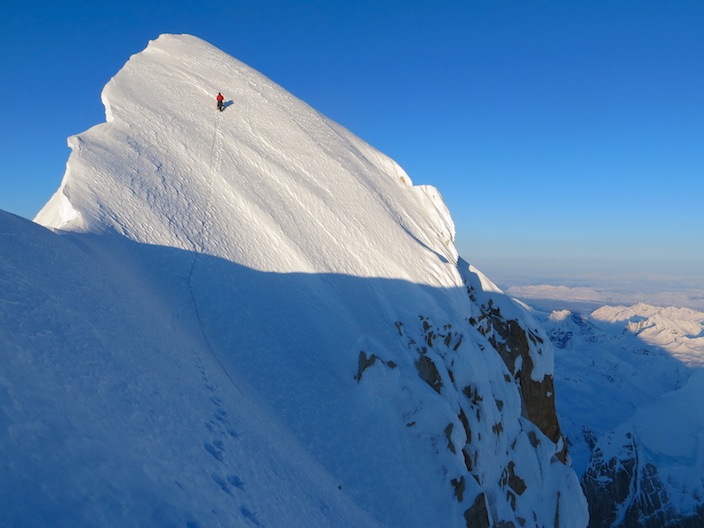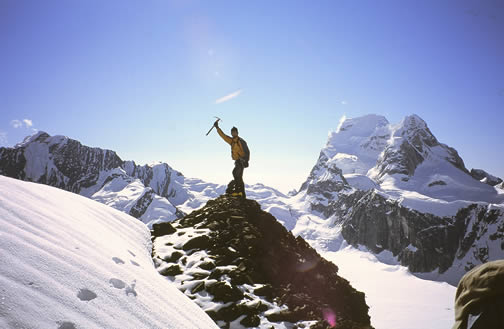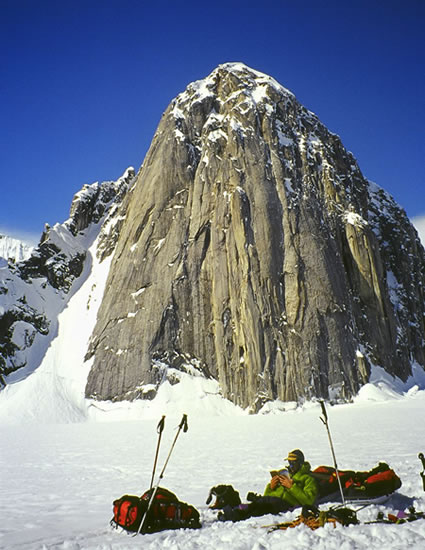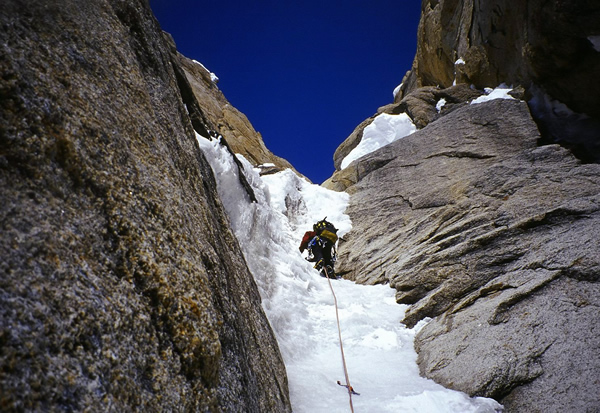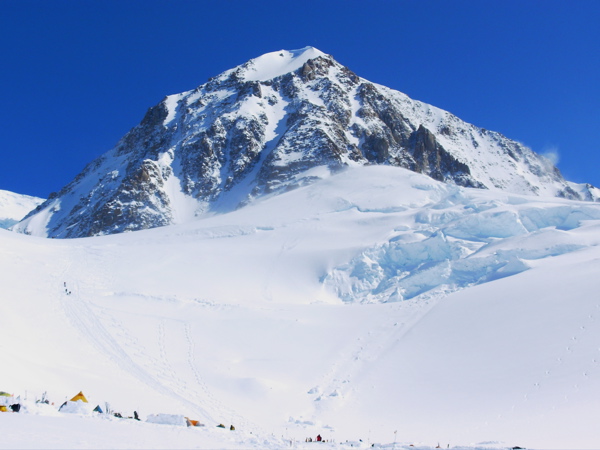Guided Alpine Climbing in the Alaska Range Overview The Central Alaska Range is made up of the peaks and valleys that surround Denali, Mount Hunter, and Mount Foraker. In the deep glacial gorges that drop from Denali's flanks sit some of the most impressive and awe-inspiring mountains in world.
Alpinist worldwide have been drawn to the Alaska Range since the early sixties, when climbers like Lionel Terray and the Harvard Mountaineering group made auspicious and ground breaking ascents on Denali and other peaks in the range.
This trend continues to this day with single-push ascents of some of the biggest alpine walls in the world. Despite the allure of the range to elite alpinists, the Alaska Range has equally as much to offer to mountaineers interested in moderate to intermediate glacier climbs, as well as to climbers looking to advance their level of skill by trying to climb progressively more serious routes in a spectacular setting.
Climber gaining a ridge on the Moose's Tooth above the Ruth Gorge.
Guided Alpine Climbing in the Alaska Range Moderate Ascents in the Alaska Range The peaks and routes listed below represent a few handpicked routes of the almost limitless possibilities available to climbers of all ability levels in the Alaska Range. Choosing an objective in Alaska warrants personal consultation and even in this day and age, there are possibilities for first ascents throughout the Alaska Range. AAI has some of the best resources available for anyone interested in climbing and exploring Alaska.
Explorer's Peak (8,540') 7 days, moderate glacier climbing Consolation Peak (7,272') 7 days, moderate glacier climbing Kahiltna Dome (12,525') 7-10 days, moderate glacier climbing
Mount Crosson from Denali Base Camp. The climbing route is the sunlit ridge at center. Coley Gentzel
Mount Crosson (12,800') 7-12 days Radio Control Tower (8670') 5-7 days Backcountry and Ski Mountaineering 3-10 days The valley and gorge glaciers of the Alaska Range offer perhaps the most scenic ski touring venue in the planet. In the Ruth Glacier Gorge, there are a number of possibilities for ski ascents and descents of moderate ski mountaineering objectives. For skiers who want to simply see the area, the Ruth and Kahiltna glaciers offer miles upon miles of touring possibilities on gentle terrain. Guided Alpine Climbing in the Alaska Range Intermediate Ascents in the Alaska Range The peaks and routes listed below represent a few handpicked routes of the almost limitless possibilities available to climbers of all ability levels in the Alaska Range. Choosing an objective in Alaska warrants personal consultation and even in this day and age, there are possibilities for first ascents throughout the Alaska Range. AAI has some of the best resources available for anyone interested in climbing and exploring Alaska.
An AAI Guide settles in for some afternoon reading below Mount Barrill. Coley Gentzel
Mount Barrill (7,650') Japanese Couloir, 5-7 days
Peak 11,300 (11,300') Southwest Ridge, 8-12 days
An AAI guide skis towards the Southwest Ridge of Mount Frances on the Kahiltna Glacier. Coley Gentzel
Mount Frances (10,450') Southwest Ridge, 5-7 days
The Northeast Ridge of Mount Frances is a snow and ice climb along the crest of a narrow and exciting ridge. The difficulty is moderate throughout, but there are steps of steep ice climbing along broken sections of the glaciated ridge.
Mount Foraker from Denali Base Camp. The upper part of the Sultana Ridge forms the righthand skyline. Coley Gentzel
Mount Foraker (17,400') Sultana Ridge, 14-20 days
From Denali Base Camp on the Southeast Fork of the Kahiltna, the route crosses the main fork of the Kahiltna and climbs up and over Mount Crosson to gain the ridge that eventually leads to Peak 12,472 and to the Sultana Ridge proper. From the typical high camp on the Sultana, the summit is over 4000 feet away, making the summit day a very long and arduous one.
Mount Russell (11,670') North Ridge, 8-10 days
For climbs of Mount Russell's North Ridge, we land on the Yentna Glacier at or above 8,000 feet. Groups typically make a camp on the ridge at just over 10,000 feet, leaving just under 2000 feet of climbing on summit day. The ridge is continually challenging and offers very consistent 50 to 60-degree snow and ice climbing with a few steeper and more exposed sections. Despite its smaller scale, a climb of Mount Russell is a committing undertaking and a very rewarding challenge.
Little Switzerland Alpine Rock Climbing, 7-14 days
Guided Alpine Climbing in the Alaska Range Advanced Ascents in the Alaska Range The peaks and routes listed below represent a few handpicked routes of the almost limitless possibilities available to climbers of all ability levels in the Alaska Range. Choosing an objective in Alaska warrants personal consultation and even in this day and age, there are possibilities for first ascents throughout the Alaska Range. AAI has some of the best resources available for anyone interested in climbing and exploring Alaska.
An AAI guide high in the Ham and Eggs couloir on the Moose's Tooth. Coley Gentzel
Mooses Tooth (10,335') Ham and Eggs Couloir 8-10 days
Most climbers attempting the Ham and Eggs route fly directly into the glacial basin below the route called the Root Canal. From here, the climb can be done in one very long day by fast parties. For parties starting in the Ruth Gorge, it will take one day to climb to the Root Canal from the Ruth Glacier below.
The difficulty of this route varies quite a bit with the amount of snow and ice in the gully. When there is a lot, the climb involves snow and ice up to about WI3+ in difficulty. In leaner conditions, there can be mixed steps and ice climbing to solid WI4. More often than not there is a little of everything on this climb, and climbers need to be comfortable on hard WI4 and capable of making moves over mixed snow and ice. The route gains nearly three thousand feet from the base to the summit and so the climbing day is a long and strenuous one. The descent is done by rapelling the route, usually over 20 double rope rappels, and the round trip from camp often takes 20 or more hours.
Mount Huntington (12,240') West Face Couloir, 10-14 days
Like all snow and ice climbs in the mountains, the difficulty of the route varies with the condition of the route. In some years, the West Face Couloir can have thin ice and mixed climbing at the entrance. In most years, the couloir is straightforward albeit strenuous climbing on snow and in places on very hard water ice.
From the top of the couloir, we traverse on mixed ledges to the base of the summit icefield. The summit icefield can be the crux of the route depending on its condition. When it is snow, protection can be hard to find. When it is ice, the protection is better but the climbing is very strenuous and sustained. From the top of the icefield the summit is a short walk along the crest of the ridge with another short ice step just below the top.
The North Face of Mount Hunter above Denali Base Camp. The upper West Ridge is the righthand skyline. Coley Gentzel
Mount Hunter (14,570') West Ridge, 12-14 days
The West Ridge is a very demanding mountaineering objective that combines a long approach with technical difficulties, exposure, and some objective danger. Most parties gain the route from the toe of the West Ridge, but during periods of stable snow conditions, the Northwest Basin approach is shorter and more direct, though also more difficult.
The climbing on the ridge is on snow and ice throughout. Low on the ridge climbers can encounter a mixed step going through a rock feature that resembles rabbit ears. Higher on the ridge we traverse enormous cornices generally staying on the south side of the ridge. On summit day we climb an ice dome that involves nearly 800 feet of sustained ice climbing that averages 60 degrees. Above the ice dome the angle starts to ease, and after we thread our way through a band of seracs we gain the summit plateau. The walk across the summit plateau to the base of the final ridge gives climbers an incredible chance to relax and take in the panoramic views of virtually every peak in the range.
Kahiltna Queen (12,380') West Face, 5-7 days
Mini Moonflower Central Gully, 5-7 days
The Direct West Buttress above Motorcycle Hill on the West Buttress route of Denali.
Denali (20,237') Direct West Buttress, 10-14 days
AAI Denali Expeditions
Denali - West Buttress
Denali - West Rib
Denali - Cassin Ridge
Guided Alpine Climbing in the Alaska Range Dates and Details Please contact the AAI office at 360-671-1505 or email at [email protected] for details about dates and pricing of this private program.
Mooses Tooth from the Ruth Gorge. Coley Gentzel.
Prerequisites Varies depending on climb. See climb descriptions
Program Cost Inclusions and Exclusions
The stated guide fees include food and group gear for the trip. Glacier flights, in-town expenses, and travel expenses are not included. Please contact AAI to receive a formal estimate of trip costs.
Guided Alpine Climbing in the Alaska Range Related Courses
Program Finder
By Location
United States - Alaska
United States - Washington
United States - California
United States - Nevada
United States - Colorado
United States - Utah
Canada - British Columbia
South America - Argentina
South America - Bolivia
South America - Ecuador
South America - Patagonia
South America - Peru
Europe - Alps and Caucasus
Asia - Nepal and Tibet
Asia - Laos, Thailand, & Vietnam
Asia - China
Asia - Japan
Africa - Tanzania
Pacific and Antarctica
By Program Type
Instructional Courses
Group Summit Climbs
Expeditions
Skills Expeditions
Private Guided Programs
Treks, Tours, & Backpacking
Corporate Outings & Services
Government & Military
By Activity
Rock Climbing
Ice Climbing
Alpine Climbing
High-Altitude Climbing
Trekking and Backpacking
Skiing & Snowboarding
Guide Training & Rescue
Avalanche Training
Departure Month
Difficulty Level
Beginner
Moderate
Intermediate
Advanced
Very Advanced
x
